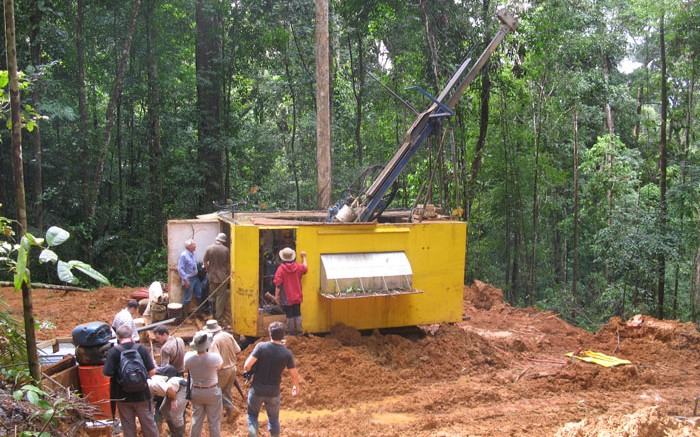VANCOUVER — What a difference a deal can make.
In October, Columbus Gold (TSXV: CGT; US-OTC: CBGDF) found in Russian gold major Nord-gold (LSE: NORD) a partner willing to spend US$30 million exploring Columbus’ Paul Isnard project in French Guiana in exchange for a 50.01% stake in the multi-million ounce gold deposit.
Investors loved the news, sending Columbus shares up 30% in a few days. But Columbus’ share price soon settled back to where it had been and remained there for several months.
Then 2014 hit, bringing one reminder after another of the import of the Nordgold deal. Those reminders have lifted Columbus’ share price 57% since the start of January, when Columbus shares were worth 30¢, to now sit at 47¢.
The most significant reminder is the ongoing 27,600-metre drill program, which got underway in November but has now picked up speed. It will progress even more quickly in May, when a second rig will likely be added.
For now, it seems Columbus and Nordgold only need one rig to prove the strength of the Montagne d’Or deposit at Paul Isnard. The drill has completed 35 holes totalling 4,126 metres, and the partners have released assay results for the first 12.
The gold at Montagne d’Or is hosted in a 400-metre-thick sequence of intercalated felsic and mafic volcanic rocks that strike east–west and dip steeply south. The known resource sits within four closely spaced horizons: the Hangingwall zone, Upper Felsic zone (UFZ), Lower Favorable zone (LFZ) and Footwall zone (FWZ).
The latest holes were collared at the deposit’s northern base to test the near-surface projection of the LFZ and FWZ. The 12 holes returned best results from the two zones, including 6 metres grading 6.06 grams gold, 17.7 metres of 2.27 grams gold, 8.8 metres of 3.5 grams gold and 2.9 metres of 11.67 grams gold.
Several holes were collared into the UFZ to reach the LFZ and returned the best UFZ results, including 27 metres of 1.26 grams gold and 4 metres of 6.57 grams gold.
Montagne d’Or is already home to 5.37 million oz. known gold, contained in an inferred resource totalling 117.1 million tonnes at an average grade of 1.43 grams gold. The resources sit within a zone measuring 2.3 km long and 400 metres wide, and mineralization has been tracked to an average depth of 250 metres from surface.
Paul Isnard is located in northwest French Guiana, within the Guiana gold belt that stretches from western Venezuela eastward through Guyana, Surinam and French Guiana into Brazil. The greenstone gold belt includes several gold deposits, such as Las Cristinas and Toropoaru.
To earn its 50.01% stake in Montagne d’Or and other Paul Isnard mineral claims, Nordgold has to spend US$30 million exploring the property over the next three years and produce a feasibility study. The Russian major has to pay Columbus US$4.2 million within the next few months, in consideration of Columbus buying an underlying royalty on the property.
The current drill program is an infill effort, intended to upgrade confidence in the resource, specifically the open-pittable part of Montagne d’Or.
The work will inform an updated resource estimate and preliminary economic assessment, both of which are expected at year-end.
Paul Isnard is Columbus’ flagship project, but the company also has a team advancing Eastside, its Nevada gold property.
Located 40 km west of Tonopah in Esmeralda County, Eastside is home to two high-grade gold mineralization zones in silicified and quartz stockworks that are surrounded and overlain by lower-grade gold within altered rhyolites. The West zone follows a steep, northerly trending fault and has been tracked for 600 metres along strike, while the East zone is associated with two or more north-trending fault structures.
Columbus’ 2013 drill program at Eastside returned promising intercepts, including 27 metres of 1.82 grams gold within 54 metres of 1.11 grams gold. The drill program followed up on the company’s 2012 discovery hole, which hit 13.6 metres of 2.42 grams gold.
The company is back at Eastside for a third-phase program, and the effort has already produced good results. The strongest result so far came in hole 27, which returned 64 metres grading 1.43 grams gold, including 8 metres of 5.86 grams gold. Nearby, hole 36 cut 48.8 metres of 0.92 gram gold.
Hole 32, designed to probe for mineralization between the zones, returned a gold–silver intercept from 337 metres depth believed to be the downdip extension of the East zone.
The rhyolite flow-dome package that hosts gold at Eastside makes up a belt 3 km wide and 18 km long within Columbus’ land position. The company is completing property-wide mapping and sampling, and the work has already tracked faults south from known mineralization for 1.6 km.
Columbus hopes to test the targets that emerge from the reconnaissance program in the second half, and is working to permit roads, drill pads and several hundred drill holes.
Columbus has 121 million shares outstanding, 138 million fully diluted.
Editor’s note: An earlier version of this story incorrectly stated that Nordgold was the operator at Montage d’Or and that the ongoing drill program includes stepout drilling. This version has been corrected.


Be the first to comment on "Columbus rises as Nordgold advances Montagne d’Or"